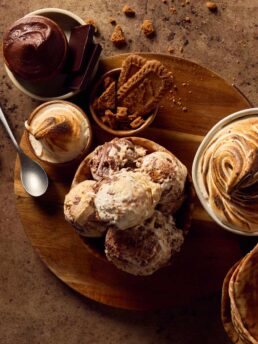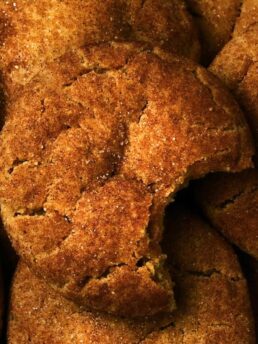The Ultimate Guide to Toasted Milk Powder

Hot take…the popularity of using browned butter in mainstream recipes is doing us all a disservice. Toasted milk powder is 10/10, hands-down better and no one seems to know about it. In so many culinary applications, it does more for texture, structure, and flavor than brown butter could ever imagine. The industry has kept milk powder and its wild, creative, 2nd born sibling, toasted milk powder, a secret for far too long. And, I say, it’s time to set the record straight.
What is toasted milk powder?
Toasted milk powder is exactly what it sounds like, powdered milk that has been toasted until it looks golden or brown in color and tastes, and smells, rich and nutty. The toasting typically involves applying heat to the milk solids in the powder, leading to the Maillard reaction — a complex chemical reaction of specific amino acids (proteins) and reducing sugars.
Generally, milk powder benefits the texture of a dish, as described below.
- In Baking: milk powder (in general) will add extra moisture retention; providing a more tender crumb in cakes, creaminess in ice cream, and a chewier texture in cookies.
- In Cooking: milk powders will provide additional creaminess and viscosity to things like pan sauces or add extra flavor in recipes like frying batters.
Toasting milk powder does the above and adds a HUGE browned butter-flavor boost to the mix.
What does toasted milk powder taste like?
Toasting milk powder adds depth and warmth to the natural sweetness of milk powders.
In most milk powders, toasting creates a caramel-like, malted, and nutty taste. (This is not to say caramelization has taken place, as that has to do with sugar, not protein, decomposition and higher temperatures. However, in some milk powders (coconut, buttermilk, and malted milk powder) the nuttiness from toasting lessens the milk powder’s natural tang and mellows them out.
Depending on what you are looking for flavor-wise, it might be better not to toast your powdered milk. So, consider this if you plan to add milk powders to recipes (read about milk powder).
How do you toast milk powder?
Toasting milk powders, regardless of the base product, requires one thing: heat. They can be dry toasted by themselves or in butter. Butter has all of its liquid evaporate during the browning process, so it can be considered dry cooking.
Toasting Animal-Based Milk Powder
Unfortunately, toasted milk powders can’t be purchased pre-made. (I’m looking at you Carnation, Nestle!) So, I suggest making at least 1 cup (100g) of toasted of milk powder at a time and keeping it in your pantry for later use (not an option for #2).
You can toast powdered animal-based milk in five different ways. I, personally, only recommend the first two on this list, but I want to make sure you have all of the information. So, I’ve included instructions for all the options, and you can decide what suits you best or what you’d like to experiment with. For all of these (except butter toasting), if the texture of the milk powder is clumpier then you’d like, let it cool and blend the final product.
- Using your stovetop (dry-toasted/bulk)– Add as much powdered milk as you’d like to make to a pan. Turn the burner to low/medium-low temperature for about 1 hour. Just like a roux, keep moving the powder around the pan so it doesn’t burn. Break up any pieces that begin to clump together as best as you can. The powder will go from an ivory color all the way to a toasted deep golden color.
If too much of the milk powder is sticking to the bottom of the pan and you are having trouble scraping it up, turn your heat down or remove the pan from the burner to scrape and then return it to the heating element to continue. When you achieve a warm light brown color, remove from the burner and set aside to cool. Done!
Of Note: I like to toast the milk powder until it’s the same medium umber color that milk solids get when you brown butter. So, I suggest using that as a benchmark. Technically, however, anything between ochre and medium umber is good to go. The darker the color the more nutty, deep flavor you’ll have. The least amount of time I would spend toasting is probably around 30 minutes.
The higher the fat content in a milk powder, the more it will clump when it’s toasting. - Using your stovetop (butter-toasted/single-use)– With this strategy milk powder can be toasted in mere minutes. However, you already need to be browning butter. When the butter just melts, add the extra powdered milk and continue as normal. This tactic toasts the dried milk solids along with the butter’s milk solids, so you can double the browned butter flavor without any extra effort. I call it “Boosted Browned Butter”.
- Using a microwave (dry-toasted/bulk) – I’ve heard mixed results for this option. Some say it works, while others say it cooks the milk powder unevenly or quickly creates unbreakable clumps. I haven’t tried it, personally, for those reasons. According to Ideas in Food(1) you can cook (1 cup) 100g of powdered milk in 30-second increments for 10 minutes and have a golden milk powder in 1/6 of the time as dry toasting it on the stovetop. Make sure to break up clumps between rounds!
- Using the oven(2) (dry-toasted/bulk)– Heat your oven to 300°F (149°C). Spread the powdered milk onto to a parchment paper-covered baking tray and place it in the oven for between 6-9 minutes. You’ll need to stir the toasting powdered milk at least twice while it bakes. And, you guessed it, break up the clumps as you go.
- Using a pressure cooker(3) (dry-toasted/bulk) – Add un-toasted milk powder into a glass jar and loosely screw on the lid. (This allows for the air to be forced out of the jar during cooking.) Then place it into a pressure cooker. Pour water around around the jar, roughly 1/2-2/3rds of the way up the level of milk powder, to prevent scorching. Then, cook the milk solids for 90 minutes. When done and everything has cooled down, remove the jar and use it as needed.
As I said before, you are welcome to use any of these options, however, the first one would be my preferred choice. Why you ask? Well, I am a HUGE control freak and knowing how quickly this ingredient burns makes me never want to take my eyes off of it. Especially in the cases where I’m distilling the cooking time down from 1 hour to only 10 minutes, I want to be watching the milk powder cook the whole time.
That being said, if you are consistently successful with the last three methods I would love to hear about your experiences. 🙂 If there’s enough positive feedback, I might change from my tried and true, stovetop methods.
Toasting Plant-Based Milk Powder
Unfortunately, plant-based, toasted milk powders also can’t be purchased pre-made. (This time I’m looking at BareOrganics and innumerable others! Please, SOMEONE pick up the torch!) So, based on compositional data(4 and 5) and my experience toasting animal/plant-based milk powders, I recommend using options that have higher fat and protein content (cashew, soy, or almond). They will more closely mimic the texture and chemical reactions of a toasted animal-based milk. That being said, I have only ever found coconut milk powder (also lower in cost) in my local supermarket. I have, however, used it to great effect. So, use what you can find and what works within your budget!
Real talk, plant-based milk powders burn, FAST and can be fussy. So using the microwave or oven is a no-go, IMO. There’s too high of a chance for them to burn or get oily with quick cooking methods that you cannot monitor. So, here are both bulk and single-use methods for toasting plant-based milk powders on your stovetop:
- Stovetop (dry-toasted/bulk)– Add as much powdered milk as you’d like to make to a pan. Turn the burner to low/medium-low temperature for 15-20 minutes. Just like a roux, keep moving the powder around the pan so it doesn’t burn. Break up any pieces that begin to clump together as best as you can. The powder will go from an ivory color to a light buttery color.
If too much of the milk powder is sticking or clumping, that’s a sign turn your heat down or remove the pan from the burner to scrape and then return it to the heating element to continue. When you achieve a warm, light golden color, remove it from the burner and set it aside to cool. Done!
Of Note: I suggest you taste the powder as you go. As color isn’t a huge indicator when the cooking time is so short, it’s important to start tasting after about 10 minutes of toasting. The milk powders may not seem burned, but they will start to become bitter as they overcook.
The higher the fat content in a milk powder, the more it will clump when it’s toasting. If you don’t like the texture of the milk powder when you are done, let it cool and blend it.
I also suggest bulk toasting at least 1 cup (100g) of dry milk powder at a time and keeping it in your pantry for later use. That way, you can skip a step in your next recipe! - Stovetop (butter-toasted/single use)– With this strategy plant-based milk powders can be toasted in even less time.
- For regular butter: Add the extra powdered plant milk once you begin to see the milk solids changing color. This tactic toasts the butter’s milk solids and lessens the amount of time the additional milk powder is cooking at medium-high heat. This way you can double the browned butter flavor without scorching or splitting the plant-based milk solids with high heat.
- For vegan butter: Melt and toast both the plant-based butter and plant-based milk solids together, on low-medium to medium heat. You can use any vegan butter, but keep in mind both what you are using it for (temperature/texture) and how you’d like it to taste. (e.g., Coconut oil with toasted plant-based milk solids say — coconut milk powder — is amazing in baked goods and yogurt-based sauces.)
Of Note: If you’re vegan and looking to make browned butter from a single product, I suggest using Miyoko’s European Style Vegan Butter. It contains cashew milk solids, which brown just like regular milk solids, and provide a richness similar to browned butter. If you want to boost this product with additional plant-based milk powder, add it after you see the cashew milk solids turn light brown.

How do you store toasted milk powder, once you make it?
Dry-Toasted Milk Powder
Store toasted milk powder in a sealed container, at room temperature. Keep toasted milk powders (made from milk powders purchased from the store) for as long as the original powder’s expiration. Just store it in a well-sealed container and keep it away from heat. I like to use mason jars/glass jars so the powder doesn’t take on any residual flavor from plastic. You can also simply dump all of the milk powder from its container into a pan and toast it. Then, put the toasted product back into the original container. Easy!
Butter-Toasted Milk Powder
Toasted milk powder that has been browned in butter or a butter alternative (boosted browned butter) isn’t very bulk or pantry-friendly. Boosted browned butter lasts up to 2 weeks in the refrigerator or 3 months in the freezer, if you want to make it ahead of time. Just make sure to thaw the frozen butter in the refrigerator beforehand.
Why is toasted milk powder better than browned butter?
If you’re thinking, “toasted milk powder sounds weird and seems labor intensive.” Seriously, hear me out.
Toasted milk powder is better because:
- You can create the browned butter flavor without needing any butter — FREEEEEDOMMMMM!
When you brown butter, it’s the toasted milk solids that create that nutty, toasty flavor. Now, butter comprises only 1-2% milk solids. So, say you are making a recipe that calls for a stick and a half of browned butter (3/4c or 170g). That recipe, maybe, has 1/2 tablespoon (3-5 grams) of milk solids in it. Adding toasted milk powder to recipes allows you to increase that caramelized flavor and customize a recipe’s richness to your tastes, without being beholden to how much butter you have to use to get it. - With baking in particular, you enjoy the best of both worlds. You can have that delicious browned butter flavor and still cream your softened butter and sugar (traditional) or softened butter and flour (reverse creaming). We have separated the ingredients. So, we can use them independently in both different stages and techniques of cooking.
- You don’t need to change recipe ratios. Browning butter decreases a recipe’s moisture content by 1 tbsp (15ml) per stick of butter. If you use toasted milk powder, you no longer need to make this calculation during recipe development. Now, you can play and experiment more without chemistry getting in the way.
- Making toasted milk powder in bulk saves time. You can skip browning butter or toasting milk powder for every subsequent recipe until your stash is gone. Some recipes that use browned butter also require you to cool it before moving forward. Because you don’t need to melt butter, you can skip this step.
Pretty good reasons right?! I’m not kidding when I say toasted milk powder changes the game.
How do you use toasted milk powder?
You can use toasted milk powder in baking and cooking, just like un-toasted milk powder. And, even better, they substitute at a 1:1 ratio. Toasted milk powder provides the same textural effect as regular powdered milk with the bonus of brown butter flavor! Just remember, toasted milk powder is already cooked and will burn easier than un-toasted milk powder. So, make sure there is either moisture present or low cooking temperatures in your chosen recipe.
For Baking and Sweets:
For baking, you can safely add 5% of the flour weight in toasted milk powder per recipe. That is roughly 1 tbsp (6g) for every 1 cup (125 grams) of AP flour. For pastry applications that involve cream or custard bases, you can add up to 1 tbsp (6g) of milk powder per cup of wet ingredients — milk, water, cream, honey, and sugar, etc included.
In most milk powders, toasting creates a caramel-like, malted, and nutty taste. So, it’s a great addition to lots of desserts, like avalanche bars and caramel (Add it after the caramel is finished — remember lower heat). The base of my toasted s’mores ice cream has toasted milk powder in it. And, I have also been known to make blonde chocolate by mixing toasted milk powder and white chocolate. It’s heaven. It also promotes the Maillard reaction, for deeper color development in things like pie crusts.
For Cooking and Sauces:
Using toasted milk powder in cooking is a little more nuanced than in baking. High heat and low moisture (frying/baking/etc.) cooking techniques limit options for toasted milk powder a little more than its un-toasted counterpart. That in no way means we can’t use it. It just means we get to be more creative.
Toasted milk powder is already cooked, so it’s best for adding flavor and finishing recipes like cream-based soups, flavored mayos, and vinaigrettes. When building onto recipes this way, it’s going to be an exercise in tasting. Add a little at a time until you are happy with the consistency and flavor.
Resources
- Kamozawa, Aki. “Microwave Milk Powder” Ideas in Food, 2013, https://blog.ideasinfood.com/ideas_in_food/2013/11/november-25-2013.html. ↩︎
- Browne, Erin. “Toasted Milk Pie.” Brownie Bites, 5 Dec. 2016, https://www.browniebites.net/toasted-milk-pie/. ↩︎
- Kamozawa, Aki. “Toasted in a Jar.” Ideas in Food, 2010, https://blog.ideasinfood.com/ideas_in_food/2010/02/toasted-in-a-jar.html. ↩︎
- Moore, S. S. et al. “How animal milk and plant-based alternatives diverge in terms of fatty acid, amino acid, and mineral composition.” npj Science of Food, vol. 7, article number 50, 16 September 2023, https://www.nature.com/articles/s41538-023-00227-w. ↩︎
- Walther, Barbara et al. “Comparison of Nutritional Composition Between Plant-Based Drinks and Cow’s Milk.” Frontiers in Nutrition, vol. 9, article number 988707, 2022, https://www.ncbi.nlm.nih.gov/pmc/articles/PMC9650290/. doi: 10.3389/fnut.2022.988707. ↩︎




I have whole milk, milk powder from the brand King Arthur, can you use that for the snickerdoodle and chocolate chip cookie recipe or does it require nonfat milk powder? Thank you
Hi Pam!
You can definitely use your whole milk powder. Non-fat and whole milk powders are pretty interchangeable for this usage. I actually prefer to use whole milk powder for my toasted milk powders, because the added fat gives a bit more richness and moisture retention in baked goods and custards. It does mean that whole milk powder likes to clump up a bit more than non-fat milk powder when toasting, so be a little more vigilant your first time. Have fun!